Let’s dive into effective, targeted exercises to tackle lower back fat.
You’ll discover 11 powerful exercises, each specifically designed to reduce back fat and enhance muscle definition. Learn the step-by-step techniques to execute these exercises for maximum impact, whether you’re a beginner or a fitness buff.
Plus, we go into crucial insights into the causes of back fat and how to address them through diet and lifestyle adjustments.
Jump to:
- 1. Dumbbell Renegade Rows
- 2. Seated DB Military Press
- 3. Push Ups
- 4. Bent Over Lateral Arm Raises
- 5. Rear Deltoid Rotations
- 6. Swimmers
- 7. Bent Over DB Rows
- 8. Reverse Fly
- 9. Resistance band pull-down
- 10. Back Extension
- 11. Kettlebell Swings
- What causes back fat?
- Is Back Fat Unhealthy?
- How to Create a Caloric Deficit
- Final Thoughts
1. Dumbbell Renegade Rows
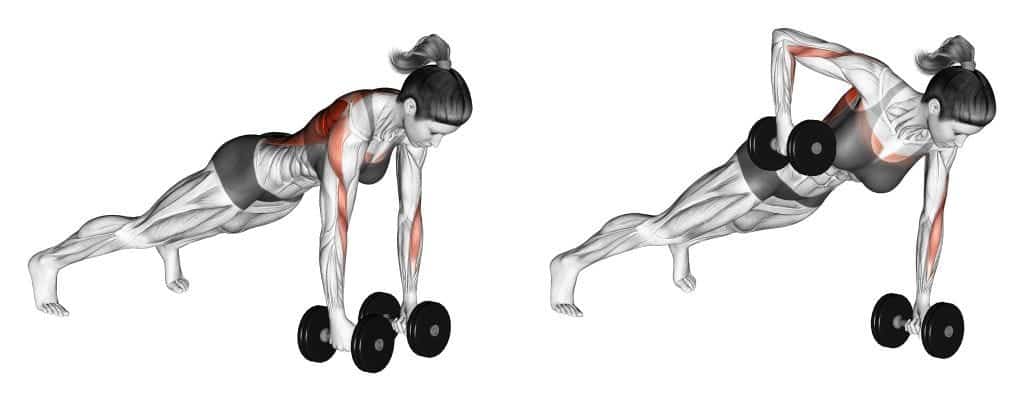
The dumbbell renegade row is an effective exercise for targeting back fat because it works several muscles in the back while also engaging the core.
How to do it:
- Position: Start in a high plank, each hand gripping a dumbbell.
- Movement: Row the dumbbell on one side to your rib area, then switch and do the same with the other.
- Target: This targets your lats and simultaneously engages your core.
- Tips: Keep your spine aligned and core engaged to maximize effectiveness and reduce injury risk.
2. Seated DB Military Press
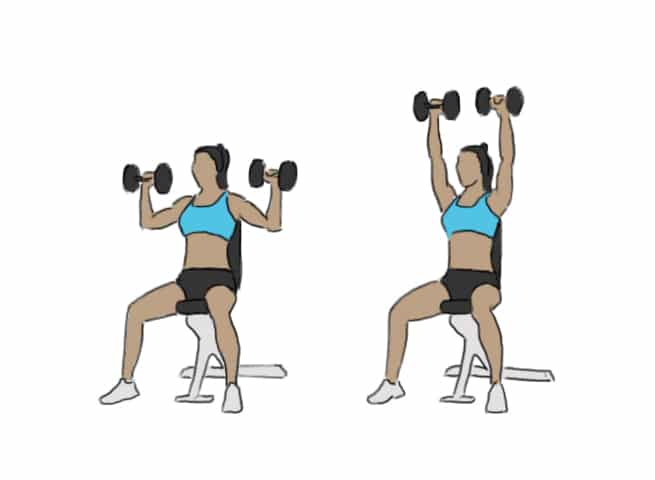
The seated dumbbell military press works the shoulders and triceps as primary movers, but also heavily recruits the upper and middle back muscles like the trapezius, rhomboids and latissimus dorsi for stabilization. Strengthening these back muscles helps improve posture which can reduce back fat.
How to do it:
- Position: Sit upright with back support, dumbbells at shoulder height.
- Movement: Press the weights upward, fully extending your arms.
- Muscles Targeted: Primarily works shoulder muscles, including the deltoids.
Steps:
- Lift dumbbells to shoulders, using thighs for assistance if needed.
- Press upwards until elbows lock.
- Return to starting position with control.
3. Push Ups

Push ups target back fat by working the latissimus dorsi, trapezius, rhomboids and other muscles along the back. Keeping the shoulder blades pulled together and back during the movement increases activation of these back muscles. This strengthens the back, improves posture, and increases calorie burn to reduce fat deposits.
How to do it:
- Hand Placement: Ensure your hands are shoulder-width apart, directly below shoulders.
- Body Alignment: Keep a straight line from head to heels.
- Execution:
- Lower down, keeping elbows at a 45-degree angle.
- Avoid dropping your hips or hiking your buttocks.
- Push through your chest and triceps to rise.
Integrating into Workouts:
- Warm-Up: Combine with jumping jacks or a plank up-down to prepare muscles.
- HIIT: Alternate push ups with high-intensity moves like burpees or speedbag drills.
- Strength Training: Follow push ups with kettlebell swings or battle ropes for a full-body workout.
4. Bent Over Lateral Arm Raises
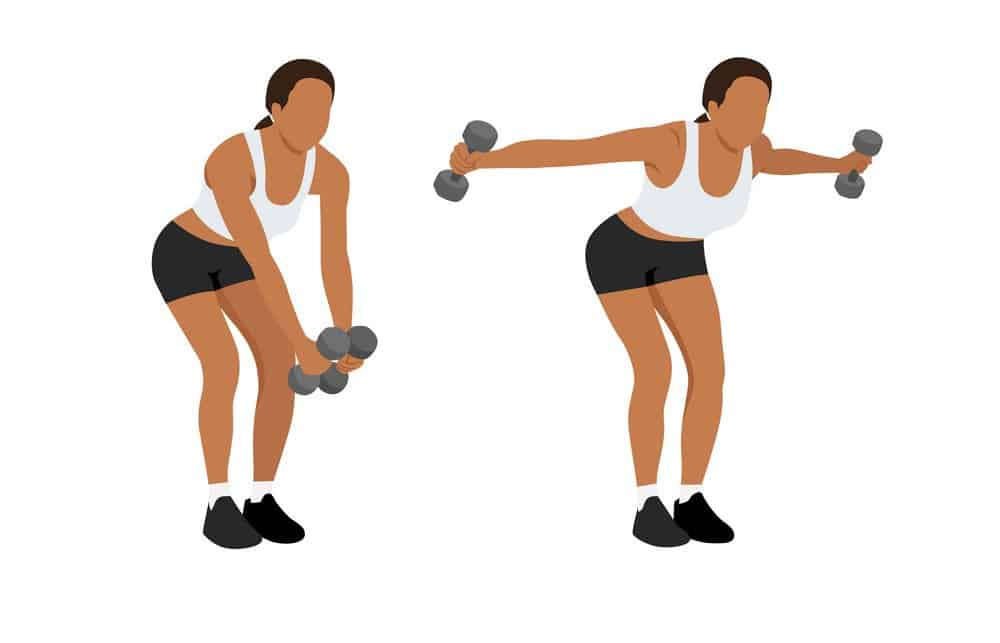
Effective for targeting lower back fat, bent over lateral arm raises require proper form:
- Position: Kneel with one hand free and the other gripping a dumbbell
- Movement: Brace your core; lift the dumbbell laterally until your arm aligns with your shoulder, then return
- Repetitions: Ensure even training by performing an equal number on each side
Maintain a steady, controlled motion for maximum engagement of your latissimus dorsi.
5. Rear Deltoid Rotations
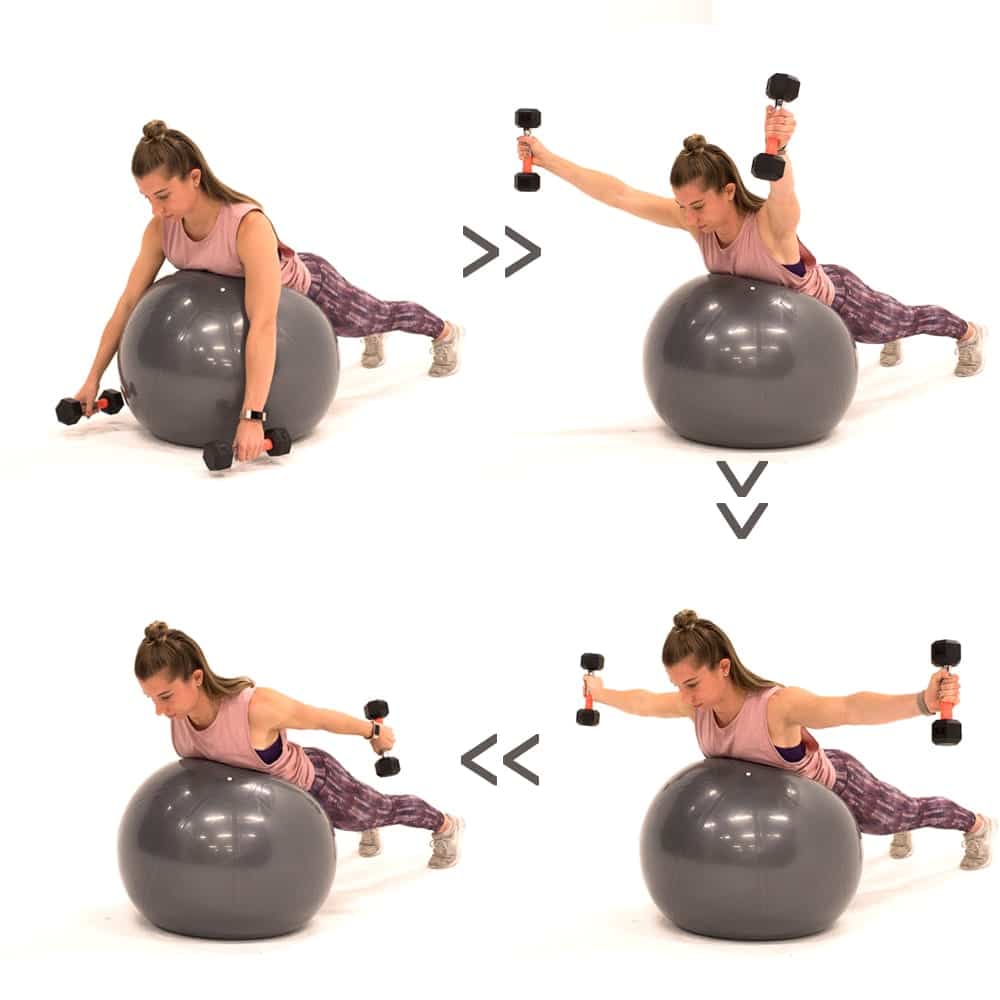
To effectively strengthen your upper back and rotator cuffs, incorporate Rear Deltoid Rotations into your routine:
- Position: Stand with feet hip-width apart, elbows bent at 90 degrees, holding a dumbbell in front of you.
- Movement: Engage your traps and rhomboids to rotate your arms outward, dumbbells moving sideways.
- Reverse: Return slowly to the starting position.
- Repeat: Perform multiple reps to tighten and build the erector spinae muscles.
Maintain your elbow’s position to maximize the benefits of the rotation.
6. Swimmers
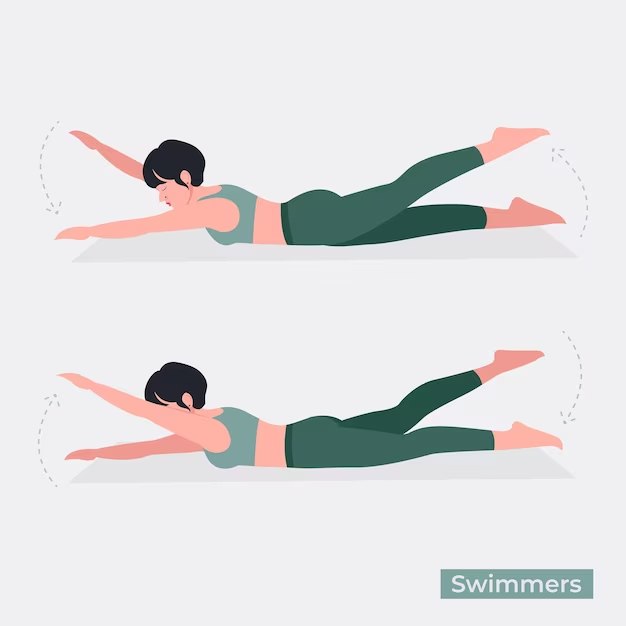
Swimmers, an exercise where you alternately lift your opposite arm and leg while lying face down, effectively target the muscles in your lower back, upper back, and glutes. This exercise engages multiple muscle groups in the back, which can help tone and strengthen these areas, potentially reducing the appearance of back fat.
How to do it:
- Start by lying on your stomach.
- Activate glutes, lifting legs from the ground.
- Extend arms forward; keep palms down.
- Alternately raise arm and opposite leg.
- Swap sides rapidly for maximum efficacy.
7. Bent Over DB Rows

Bent Over Dumbbell Rows specifically target the muscles in the upper and middle back, such as the latissimus dorsi, rhomboids, and trapezius. By engaging these muscles, the exercise helps to strengthen and tone the back, which can aid in the reduction of back fat. Additionally, it can improve overall back muscle definition and posture.
How to do it:
- Positioning: Kneel on a bench with one lower leg flat, hand on the bench for support.
- Dumbbell Placement: With a dumbbell in the free hand, keep it on the bench starting position.
- Tension & Lift: Engage your lats and lift the dumbbell until your upper arm is parallel to the floor.
- Form Check: Elbow should bend at a 90-degree angle; back straight.
- Lowering the Weight: Return the dumbbell slowly to the starting position or rest briefly on the bench.
- Repetition: Perform the recommended number of reps and switch sides.
Common Variations:
- Inverted Row: Using a bar in a Smith machine or a TRX system.
- Seated Cable Row: Utilize a cable machine for a supported back row experience.
- Deadlift into Row: Combine a deadlift with a row in one smooth motion for compound back training.
Safety Tips: Maintain a neutral spine and avoid jerky movements to prevent injury.
8. Reverse Fly
The reverse fly is a potent exercise targeting the upper back muscles, which can help you reduce back fat and improve posture. Here’s how to incorporate it into your workout routine effectively:
How to do it:
- Stand with your feet shoulder-width apart, a dumbbell in each hand.
- Slightly bend your knees and hinge forward at the hips, keeping your back flat.
- Extend your arms below your chest, palms facing each other.
- Brace your core and lift the weights out to the sides, keeping a slight bend in the elbows.
- Squeeze your shoulder blades together at the top of the movement.
- Lower the weights with control to the starting position.
Tips for Effective Execution:
- Keep your movements controlled; avoid using momentum to lift the weight.
- Ensure not to lift your arms above shoulder height.
- Increase the weight or resistance as you progress to challenge your muscles further.
9. Resistance band pull-down

The resistance band pull-down is an effective exercise for targeting the muscles in your back, particularly the latissimus dorsi, which are key to reducing back fat. These exercises can be performed with various resistance levels, allowing you to adjust the intensity to suit your fitness level.
How to do it:
- Secure the resistance band above your head to a stable object, such as a door anchor or a tall piece of gym equipment.
- Stand or kneel with your back straight, facing the anchor point.
- Grip the band’s handles with your palms facing down, hands wider than shoulder-width apart.
- Pull the band down toward your upper chest, contracting your shoulder blades together.
- Slowly release back to the starting position with controlled motion.
Variations:
- Single-arm pull-down: Work one side at a time for focused muscle engagement.
- Half-kneeling position: This position can help you concentrate on your lats without involving the lower back too much.
10. Back Extension
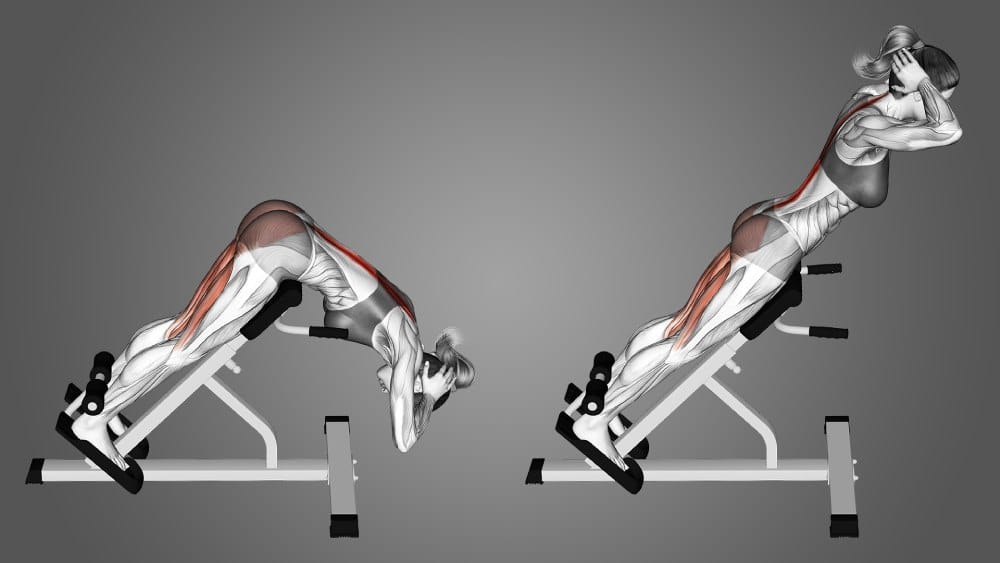
Back extension exercises are vital for strengthening your lower back muscles. They can be particularly beneficial in reducing back fat and improving posture. Here’s how you can incorporate back extensions into your fitness routine:
Stability Ball Back Extensions:
- Place your hips and stomach on a stability ball, feet wide apart for support.
- Cross your arms over your chest or place them behind your head.
- Lift your upper body by contracting your lower back muscles, then lower back down.
Roman Chair Hyperextensions:
- Position your ankles securely under the footpads of a Roman chair.
- Cross your arms over your chest, keeping your back straight.
- Bend forward at the waist and then extend back up, focusing on squeezing your glutes and back muscles.
11. Kettlebell Swings
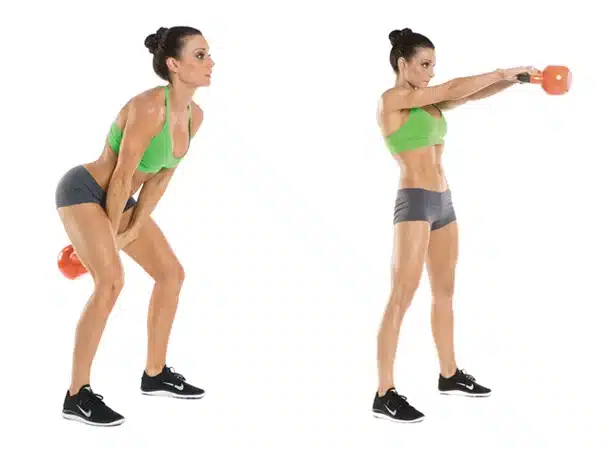
Kettlebell swings are a dynamic and powerful exercise that can target back fat by engaging multiple muscle groups. Incorporating kettlebell swings into your exercise routine may contribute to reducing body fat and improving overall body composition.
How to do it::
- Stand with your feet shoulder-width apart.
- Hold the kettlebell with both hands, arms in front of your body.
- Slightly bend your knees and hinge at your hips to initiate the swing.
- Drive through your hips to swing the kettlebell upward to shoulder height.
- Let the kettlebell swing back down, hinging at the hips again.
What causes back fat?
Back fat accumulates for various reasons, impacting both your appearance and health. Understanding these underlying causes will guide you in making effective lifestyle changes.
Dietary Habits:
- Excessive caloric intake, especially from processed foods with added sugars and saturated fats, contributes to weight gain, including back fat.
- Lack of nutrient-dense foods can disrupt your metabolism, making fat loss more challenging.
- A nutritious diet rich in fiber can help with managing calorie intake and promoting satiety.
Physical Activity:
- A sedentary lifestyle increases risks of overall body fat accumulation, including areas such as the lower back or “love handles.”
- Incorporating cardio exercise like walking can help establish a calorie deficit necessary for fat loss.
- Focusing on exercises that improve posture can also minimize the appearance of back fat.
Lifestyle Factors:
- Stress can hinder your efforts to reduce weight and back fat as it may lead to unhealthy eating habits.
- Inadequate sleep and hydration may negatively affect your body’s ability to manage weight.
- Reducing salt intake can decrease water retention, which sometimes exacerbates the look of back fat.
Genetic and Health-Related Factors:
- Genetics may predispose you to store fat in specific areas, including the back.
- Medical conditions like diabetes could influence how and where your body stores fat.
Effective Strategies:
- Aim for a healthy diet that’s low in processed foods and high in whole, natural options.
- Increase your fiber intake to help regulate caloric intake.
- Engage in regular cardio exercises and activities that boost metabolism.
- Reduce added sugars and saturated fats to manage calorie consumption effectively.
- Maintain healthy habits to support fat loss, including managing stress and ensuring enough rest.
Remember, while you can’t target back fat alone, improving your overall health and reducing total body fat will lead to a leaner back.
Is Back Fat Unhealthy?
When discussing back fat, it is essential to understand that fat distribution varies for each individual and that some amount of body fat is necessary for overall health. Back fat itself is not inherently unhealthy; however, excessive accumulation can be associated with health risks. Here are some key considerations:
- Body Composition: Body fat percentage is a clearer indicator of health than body weight alone. Aim for a balanced body composition through regular physical activity and a nutritious diet.
- Location of Fat: Research implies that fat stored around the abdomen (visceral fat) carries higher risk factors than fat stored in other areas, like the back. Therefore, focusing on overall fat reduction is beneficial.
- Balance: Healthy living involves balance. Back fat should not be the sole focus but rather part of a comprehensive approach to fitness and well-being.
To manage back fat specifically, women can incorporate exercises targeting the upper, middle, and lower back. These exercises contribute to stronger back muscles, which can improve posture and appearance:
- Cardiovascular Exercise:
- Function: Burns calories, which assists in fat reduction across the body, including the back.
- Examples: Swimming, rowing, or elliptical training.
- Strength Training:
- Upper Back Exercises:
- Dumbbell rows
- Lat pull-downs
- Mid Back Exercises:
- Superman lifts
- Yoga poses like the cobra or cat-cow
- Lower Back Exercises:
- Deadlifts
- Hyperextensions
- Upper Back Exercises:
How to Create a Caloric Deficit
To reduce back fat, creating a caloric deficit is a critical component. This means you’ll need to burn more calories than you consume. Here’s how you can achieve this:
Determine Your Daily Caloric Needs: First, estimate the number of calories you need to maintain your current weight. Several online calculators can help you find this number based on your age, gender, weight, height, and activity level.
Track Your Caloric Intake: Use a food diary or a mobile app to log everything you eat and drink. Pay attention to portion sizes and hidden calories in sauces and dressings.
Implement Dietary Changes:
- Focus on nutritious, whole foods like vegetables, fruits, lean proteins, and whole grains.
- Reduce your intake of processed foods, sugary beverages, and high-fat snacks.
Increase Your Physical Activity:
- Incorporate both cardio and strength training into your routine. Cardio burns calories, while strength training builds muscle, which can increase your resting metabolic rate.
| Exercise Type | Description | Calorie Burn Estimation |
| Cardiovascular | Activities like brisk walking, running, or cycling. | High, depending on intensity |
| Strength Training | Resistance exercises targeting back muscles. | Moderate, also builds muscle mass |
Regular Aerobic Exercise: Engaging in aerobic exercise can help you burn calories and improve heart health. Consider activities such as swimming, cycling, or group fitness classes.
Monitor Your Progress: Weigh yourself regularly and adjust your diet and exercise plan as needed to continue creating a caloric deficit.
Remember, it’s essential to aim for a safe and sustainable caloric deficit. Drastic calorie reduction can be counterproductive and may lead to muscle loss or nutritional deficiencies. Always consult with a healthcare provider or a registered dietitian before starting a new weight loss regimen.
Final Thoughts
In managing back fat, holistic lifestyle choices are pivotal. Embrace activities like using a resistance band for a full range of motion exercises. Doing so isn’t about spot-treating areas; it’s about consistency and overall health. Monitor stress and cortisol levels—elements that may impact fat retention. For better control, align with CDC guidelines on physical activity to enhance your lifestyle habits.














